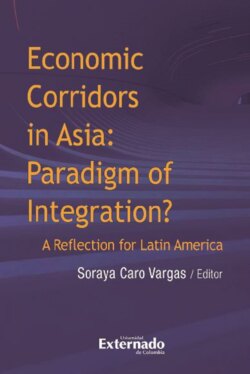Читать книгу Economic corridors in Asia : paradigm of integration? A reflection for Latin America - Varios autores - Страница 40
На сайте Литреса книга снята с продажи.
10. STRUCTURAL CONSTRAINTS AND BOTTLENECKS
ОглавлениеThe challenges that India has been facing with regard to the national infrastructure projects has been the financing of the project costs and also problems with regard to project execution and meeting the deadlines for the completion of the project. India has an infrastructure deficit and it has tried hard to get investment from Gulf countries for its USD 7.5 trillion worth of projects. However, the response from the Gulf countries has been lukewarm. Apart from the challenge of finance, the local population demands in terms of relocation, land acquisition and compensation issues, and political demands for provincial and regional priority for labor and employment in those projects, have been major causes of concern. Furthermore, the identification of core areas for development in terms of industrial projects and localized economic units supported by ancillary industries is being done with field reports and feasibility studies. Most of these studies are commissioned by the different ministers and also by private institutions such as PricewaterhouseCoopers (PWC) and other such institutions. The issues related to projects have been addressed through Special Purpose vehicles which are more project and outcome based and have been structured in such a way that their primary function is the completion of the project. The only aspect with regard to the infrastructure projects is that there has been very little foreign direct investment. Therefore, the course that the government and other institutions have taken has been to float infrastructure bonds, state and center financing of projects, long-term financing through financial institutions, tax benefits and also tax breaks to the early birds to the project. Once the projects are finished, then these loans need to be repaid and in case these projects become unviable then the escalating interest servicing and maintenance would be an issue.
The purpose of these economic corridors is to promote capital and labor flows in a seamless manner. This can have challenges given the demographic changes as well the concern with the local population about the employment destined for them being taken away by outsiders. As India already has provisions for state residency-based reservation in government jobs and therefore this might trickle down to the private sector also because of political preferences. The major challenge for a high-density population area is the land acquisition and also proper rehabilitation of the people. However, the government has taken utmost care not to disturb the populated areas and has given compensation which was much higher than the prevailing market rate. Likewise, with regard to inland waterway projects, there have been apprehensions that too much cargo movement would disturb the fish habitats and also due to shallowness in the river at certain places it would lead to problems in navigation and also affect the cargo carrying capacity of the boats or barges. Furthermore, the issue of finance has been addressed through public-private funding and also through institutions such as the World Bank. A few countries such as Japan have taken keen interest in developing the freight and transport corridors in India and also at easy interest rates, known as soft loans.
At the sub regional level, the issue emerges about economic dividends of the corridors and whether these would help capital and labor migration through seamless connectivity. This, because within Asia and particularly in Southern Asia the problem has been the issue of Mode-II and Mode IV migration, dealing with unskilled and skilled labor. Additionally, the one challenge which might become an issue in the sub regional construct is how the other economies would view the competition to their own industry. Also, whether the regional value chain would add or subtract the value of the respective products. At the sub-regional level, the infrastructure development can only pay dividends when there are free trade agreements, easy border custom procedures and simple documentation. India has made blueprints for the economic corridors, but the issue is fund generation and completion within accepted timelines. However, this has been the major challenge for most of the developing world. With growing economies and better procedures, the deadlines for better economic futures might be met.
While India has always faced problems with regard to project implementation and completion, there are challenges related to employment, corruption, labor laws and labor unrest which might lead to delays in projects. These are unforeseen circumstances which exist in any developing country. However, most of the Ministries in India work as per the blueprint and this has provided blueprints but then as those projects which have never started might face political axes as the opposition parties may wish to redraw the projects depending on their political stances.
